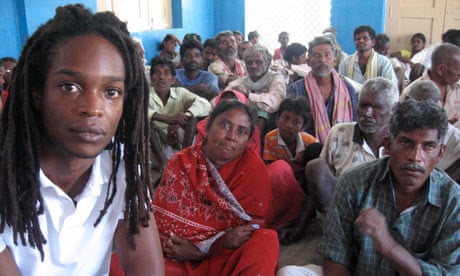Narsappa was just 10 years old when he was told he had leprosy, but the news changed the course of his life forever. People in his Indian village immediately began to shun him and told his parents that he had to leave. He says his mother started grieving for him "as if I was already dead". Shortly afterwards, his father took him to a hospital two hours away from home and left him there. No one ever came to visit him and Narsappa never went home again.
Now 42, he now lives in a leprosy colony on the outskirts of Hyderabad and campaigns on behalf of people affected by the disease. "I lie awake at night thinking about how I was treated and how I can stop others from going through the same thing," he says.
India may have one of the fastest growing economies in the world, but 130,000 Indians are diagnosed with leprosy every year – more than every other country put together. It's partly because the country's population is so huge but also, campaigners say, because the Indian government and some international donors are neglecting the fight against the disease. Hundreds of thousands of Indians suffer from leprosy and its debilitating after-effects.
Given the number of new cases, it may come as some surprise that India announced it had eliminated leprosy in 2005. According to a target set by the World Health Organisation, countries can announce 'elimination' when there are fewer than one case for every 10,000 people. Since then, the government has channelled funding previously dedicated to leprosy back into the general health system. Leprosy charities say that donations have also fallen significantly and some projects have had to close.
Leprosy attacks nerve endings, destroying the ability to feel pain and injury, which makes patients susceptible to ulcers and infections. Over time, these infections can lead to the loss of fingers, hands, toes and feet if they are not treated properly. It can also cause blindness, facial disfigurement, and the 'clawing' of hands and feet.

Many also face lifelong rejection, stigma and discrimination. There's a widespread fear that the disease is highly contagious. In reality, 95% of humans are naturally immune, which is why campaigners call it the world's "least contagious communicable disease". While doctors are still unsure exactly how leprosy is spread (it's probably by airborne droplet infection such as coughing and sneezing), it is easily treated with highly effective drugs available for free under a collaboration between the WHO and the pharmaceutical company Novartis.
Nevertheless, even those who have been cured and are no longer contagious are shunned by society and forced to live as outcasts. India has an estimated 1,000 leprosy colonies that are home to hundreds of thousands people living their lives in the disease's long dark shadow. Conditions in the colonies vary enormously: even though Shantinagar, where Narsappa lived, has no running water or toilets, the residents at least have brick houses and electricity. Other colonies are not so lucky.
A leaked copy obtained by Channel 4's Unreported World of a recent unpublished government study of the number of new leprosy cases in India suggests that the official figures don't show the true scale, and it may be much higher. This was the first time in six years health workers have carried out extensive surveys. In one Indian state, health workers found the number of people infected was five times the official estimate.
Dr Premal Das, the senior surgeon at India's busiest leprosy hospital, which is run by UK-based charity the Leprosy Mission, says: "We have no idea what is the leprosy situation at the moment because for the last 10 years no NGO has been doing any active case detection work." But he adds that his hospital saw 3,000 new leprosy cases last year – a record high.
His hospital provides a wide range of leprosy services, from wound-cleaning to surgery. Das himself carries out 500 reconstructive operations a year, mostly correcting deformities to hands and feet. One of his patients is 16-year-old Pooja, who comes from Baripur village in Uttar Pradesh and was diagnosed with the disease just a few months ago. It caused the fingers on her right hand to claw.
Thirty years after Narsappa was driven out of his village, she tells a remarkably similar story about what happened when she found out she had the disease. Through her tears, she explains how her neighbours tried to drive her out of the village. They verbally abused her and her mother, and told her parents she had to go. But Pooja was lucky - her parents stuck by her and the surgery will correct the deformity in her hand.
Dr Das says that because the disease has been officially 'eliminated', the hospital is struggling for funding. "Because they've said leprosy is no longer a public health problem in India we are struggling with budgets," he says. "It's very difficult to convince a donor that the funds are actually for leprosy because they don't think leprosy is a problem."

Comments (…)
Sign in or create your Guardian account to join the discussion